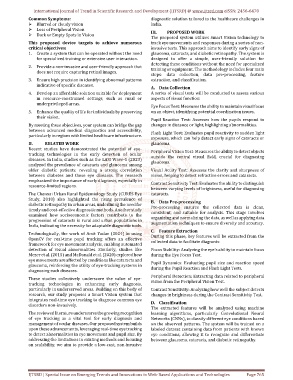Page 775 - Emerging Trends and Innovations in Web-Based Applications and Technologies
P. 775
International Journal of Trend in Scientific Research and Development (IJTSRD) @ www.ijtsrd.com eISSN: 2456-6470
Common Symptoms: diagnostic solution tailored to the healthcare challenges in
Blurred or cloudy vision India.
Loss of Peripheral Vision III. PROPOSED WORK
Dark or Empty Spots in Vision
The proposed system utilizes Smart Vision technology to
This proposed device targets to achieve numerous track eye movements and responses during a series of non-
critical objectives: invasive tests. This approach aims to identify early signs of
1. Create a system that can be operated without the need glaucoma, cataracts, and diabetic retinopathy. The system is
for specialized training or extensive user interaction. designed to offer a simple, user-friendly solution for
detecting these conditions without the need for specialized
2. Provide a non-invasive and user-friendly approach that training or equipment. The methodology includes four main
does not require capturing retinal images.
steps: data collection, data pre-processing, feature
3. Ensure high precision in identifying abnormal patterns extraction, and classification.
indicative of specific diseases.
A. Data Collection
4. Develop an affordable solution suitable for deployment A series of visual tests will be conducted to assess various
in resource-constrained settings, such as rural or aspects of visual function:
underprivileged areas.
Eye Focus Test: Measures the ability to maintain visual focus
5. Enhance the quality of life for individuals by preserving on an object, identifying potential coordination issues.
their vision.
Pupil Reaction Test: Assesses how the pupils respond to
By meeting these objectives, your system can bridge the gap changes in distance or light, highlighting abnormalities.
between advanced medical diagnostics and accessibility, Flash Light Test: Evaluates pupil reactivity to sudden light
particularly in regions with limited healthcare infrastructure.
exposure, which can help detect early signs of cataracts or
II. RELATED WORK glaucoma.
Recent studies have demonstrated the potential of eye-
Peripheral Vision Test: Measures the ability to detect objects
tracking technologies in the early detection of ocular
outside the central visual field, crucial for diagnosing
diseases. In India, studies such as the LASI Wave-1 (2023)
glaucoma.
analyzed the prevalence of cataracts and glaucoma among
older diabetic patients, revealing a strong correlation Visual Acuity Test: Assesses the clarity and sharpness of
between diabetes and these eye diseases. The research vision, helping to detect refractive errors and cataracts.
emphasized the importance of early diagnosis, especially in
Contrast Sensitivity Test: Evaluates the ability to distinguish
resource-limited regions.
between varying levels of brightness, useful for diagnosing
The Chennai Urban Rural Epidemiology Study (CURES Eye cataracts.
Study, 2010) also highlighted the rising prevalence of
B. Data Pre-processing
diabetic retinopathy in urban areas, underlining the need for
Pre-processing ensures the collected data is clean,
timely and cost-effective diagnostic methods. Another study
consistent, and suitable for analysis. This stage involves
examined how socioeconomic factors contribute to the
organizing and normalizing the data, as well as applying data
progression of cataracts in rural and urban populations in
augmentation techniques to ensure diversity and accuracy.
India, indicating the necessity for adaptable diagnostic tools.
C. Feature Extraction
Technologically, the work of Amit Yadav (2024) in using During this phase, key features will be extracted from the
OpenCV for real-time pupil tracking offers an effective
framework for eye movement analysis, enabling automated collected data to facilitate diagnosis:
detection of visual abnormalities. Similarly, studies like Focus Stability: Analyzing the eye's ability to maintain focus
Mezer et al. (2015) and McDonald et al. (2020) explored how during the Eye Focus Test.
eye movements are affected by conditions like cataracts and
Pupil Dynamics: Evaluating pupil size and reaction speed
glaucoma, reinforcing the utility of eye-tracking systems in
during the Pupil Reaction and Flash Light Tests.
diagnosing such diseases.
Peripheral Detection: Extracting data related to peripheral
These studies collectively underscore the value of eye-
tracking technologies in enhancing early diagnosis, vision from the Peripheral Vision Test.
particularly in underserved areas. Building on this body of Contrast Sensitivity: Analyzing how well the subject detects
research, our study proposes a Smart Vision system that changes in brightness during the Contrast Sensitivity Test.
integrates real-time eye tracking to diagnose common eye
disorders non-invasively. D. Classification
The extracted features will be analyzed using machine
The reviewed literature underscores the growing recognition learning algorithms, particularly Convolutional Neural
of eye tracking as a vital tool for early diagnosis and Networks (CNNs), to classify different eye conditions based
management of ocular diseases. Our proposed system builds on the observed patterns. The system will be trained on a
upon these advancements, leveraging real-time eye tracking labeled dataset containing data from patients with known
to detect abnormalities in eye movement and pupil size. By eye conditions, allowing it to recognize and differentiate
addressing the limitations in existing methods and focusing between glaucoma, cataracts, and diabetic retinopathy.
on scalability, we aim to provide a low-cost, non-invasive
IJTSRD | Special Issue on Emerging Trends and Innovations in Web-Based Applications and Technologies Page 765

